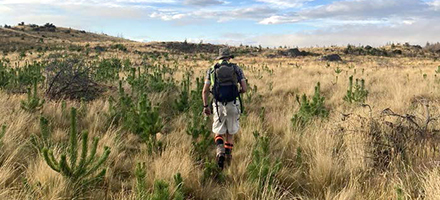
Scion ecologist Matt Scott surveys an aggressive lodgepole pine re-invasion following control operations.
Wilding conifers are a major threat to New Zealand’s environment and economy. Understanding how these species invade and re-invade the landscape is critical to win the battle against these invasive trees. Re-invasion is a complex puzzle and Scion’s research supports a nationally coordinated approach to control these problem pines. Source: Timberbiz
New Zealand is a testing ground, and this research helps with global understanding of what drives such biological invasions. Together with collaborators, Scion’s invasive plant ecologists in the Vive la résistance (VLR) research program have sampled hundreds of plots, measuring thousands of trees across five regions of New Zealand (Kaweka Range, Molesworth, Craigieburn, Mackenzie and Mid-Dome) to quantify re-invasion following control.
Scion’s VLR programme leader Thomas Paul has been researching wilding pines since 2016. He says New Zealand wilding pine invasions and their control is far further developed than in other countries across the southern hemisphere.
“This gives us the unique opportunity to study this situation and provide critical learnings to reverse invasion impacts and the know-how to manage wilding invasions and their re-invasion cycles.”
Preliminary results show that current control measures such as hand weeding, felling or herbicide application are unlikely to achieve eradication, and re-invasion is occurring.
One of the reasons for this could be that New Zealand may host a unique hybrid of Pinus contorta (Lodgepole pine), the worst wilding offender.
This hybrid produces larger cones and more viable seeds both traits that could contribute to increased invasiveness. The supposed hybrids might also possess adaptations facilitating reinvasion, but also making populations resilient to climate change.
Biosecurity New Zealand National Wilding Conifer Control program manager Sherman Smith values Scion’s expertise.
“The return of wildings to each control site can be wildly different. There are many different methods we use at different sites and in different environments,” he said.
“The new insights from Vive la résistance will help us understand their effectiveness on a longer scale than we have so far and give us greater information on how control methods are influencing re-invasion.
“Working with the team from Scion to support this research is definitely adding value both ways.”
Wilding pines are introduced species, such as Lodgepole pine, that have become invasive in susceptible environments. If not managed well, they threaten native ecosystems and the biodiversity within them, impact production lands (grazing) and change the vistas of iconic landscapes.
Wilding pines already cover more than 1.8 million hectares of New Zealand with further conservation and productive land threatened over the next 30 years.
The New Zealand Government established the National Wilding Conifer Control Program (NWCCP) in 2016 to deal with this growing problem but continuous management is required. One-off treatments cannot eliminate wildings and prevent the re-invasion of cleared land repeated cycles of maintenance are necessary.







